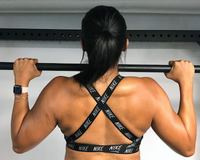
Cable Rear Delt Fly
The cable rear delt fly, also known as the reverse cable fly, is an exercise that increases deltoid muscle definition and strength. This exercise engages a variety of upper body muscles while honing in on your rear (posterior) deltoids.
Simply put, learning the cable rear delt fly will greatly improve your shoulder workout routine.
Muscles Worked By The Cable Rear Delt Fly
Primary Muscle Groups:
Given its name, it makes sense that the cable rear delt fly primarily works your rear delts. The deltoid is separated into three main fibers: the anterior, lateral, and posterior deltoids.
In this case, your posterior deltoids receive the most tension during this exercise.

Secondary Muscle Groups:
The cable rear delt fly works more muscles than just the posterior deltoids. In fact, it is an effective trapezius strengthening exercise. In addition, this motion works upper back muscles such as the rhomboids and the erector spinae.
Lastly, your core muscles activate to stabilize your body as well.
Cable Rear Delt Fly Benefits
1. IMPROVED POSTURE
Whether it be from hours of sitting, muscle imbalances, or injury, many of us struggle to maintain good posture. Thankfully, the cable rear delt fly is one of the best exercises to improve your posture. If you have weak upper back muscles, your shoulders may be prone to round and “hunch” over.
The cable rear delt fly will tighten your upper back to prevent this rounding from occurring. In addition, the added core muscle engagement from this exercise will help you maintain a straight back and active core for proper posture.
2. Stronger Shoulders
The cable rear delt fly isolates your deltoids during each rep, thus strengthening your shoulder muscles. While the cable rear delt fly is an accessory exercise, it can boost your performance in compound exercises such as the overhead press, barbell bench press, and the lateral raise.
In reality, stronger shoulders are important in every area of training. Your rear delts play a role in a multitude of exercises — you should train them accordingly!
3. Improved Aesthetics
If you are exercising to improve your physical appearance, you should aim to prioritize your shoulders. Many lifters and body builders tend to overtrain their chest and arms, leaving them with disproportionately smaller shoulders.
Building muscle symmetrically is important not only for the aesthetic benefits, but it is generally safer to promote balance in your body.
How To Do The Cable Rear Delt Fly
Equipment:
For this exercise, you will need a cable machine with handle attachments.
Setup:
a) Assume a standing position with your feet shoulder width apart.
b) Set the pulleys of the cable machine to a height just above your head.
c) Grab the left handle with your right hand and the right handle with your left hand. Your arms will start in this crossed position.
d) Stand in the center of the cable machine and take a step backwards to create some tension in the cables.
Action:
a) With a tight core, contract your rear (posterior) delts to bring your arms backward until you feel a pinch in your shoulder blades.
b) Slowly bring your arms back to the starting position. You should maintain only a slight bend in your arms during this motion.
c) Maintain tightness in your core and repeat!

Recommendation:
You should aim to complete 3-4 sets of 10-12 reps of the cable rear delt fly. Of course, as you get more comfortable with the form, feel free to change up your set and rep ranges to challenge yourself.
Cable Rear Delt Fly Mistakes
1. Bending the Elbows
Throughout the cable rear delt fly, you want to maintain a slight bend in your elbows. If you fully bend the elbows, your biceps will take over to complete the rep. While training the biceps is not harmful, we are here to build those rear deltoids.
Keep your elbows relatively straight to focus on the rear delts.
2. Completing Partial Reps
When doing the cable rear delt fly, it can be tempting to stack on tons of weight. However, the rear delts are not our body’s strongest muscle. If you use too much weight, you will end up completing partial reps.
This compromises the benefits of the exercise and even risks injury. Instead, use lighter weight and complete full repetitions. Ideally, you should bring your arms back so that your hands are in line with your shoulder at the bottom of each rep.
3. Bringing Your Arms Too Low
If you set up the pulley too low or you pull the handles downwards, you will activate your lats during the reverse fly. While this is a useful variation of this exercise, it does not maximize tension on the rear delts.
Focus on keeping your arms slightly above the height of your shoulders. As a result, you will ensure that you are working the rear delts instead of your back!
Cable Rear Delt Fly Variations
1. Bent-Over Cable Rear Delt Fly
You can also perform the cable rear delt fly in the bent-over position. Instead, set the pulleys at a low position, hinge at the waist so that your back is parallel to the ground, and retract your rear delts to bring the weight upwards.
You should feel a similar pinch in your shoulder blades at the top of each rep.

2. 1-Arm Standing Cable Rear Delt Fly
In order to correct any shoulder muscle imbalances you may have, you can perform the cable rear delt fly unilaterally. In this variation, the form remains the same but you are only pulling one arm at a time.
Keep your core tight throughout for the best results.

3. Bent-Over Dumbbell Reverse Fly
If you prefer to exercise with free weights instead of cables, grab a pair of dumbbells for this rear delt fly variation. Hinge at the waist, engage your core, and retract your shoulders to bring your arms straight out to the side.
Return to the starting position in a controlled fashion and repeat!

Cable Rear Delt Fly Alternatives
If you enjoyed the cable rear delt fly, check out these shoulder exercises to improve your upper body training:
1. Standing Rope Face Pull
Set the pulley to the highest setting and grab the balls of the rope. Keep your arms elevated and pull the handles to either side of your face. You should feel a strong pinch in your shoulder blades.

2. Bent-Over Kettlebell Face Pull
Hinge at the waist and bend over so that your back is nearly parallel to the floor. Retract your rear delts as you drive your elbows up and slightly back, bringing the kettlebell right beneath your face.
Make sure to keep your elbows above your wrists and you should feel a pinch in your shoulder blades at the top of each rep! Repeat!

3. Plank-Ups
Assume a plank position with your forearms on the ground and your legs straight out behind you. Your forearms should make a 90 degree angle with your upper arms.
Engage your core and make sure your back is completely straight.
Pinch your shoulder blades together as you lower downwards until you nearly touch the ground. Contract your rear delts to explode back up to the starting position.
Maintain tightness in your delts and repeat!

Looking For More Shoulder Workouts?
Check out this intense 5 minute kettlebell shoulder workout!
Join the Invasion!
This Anabolic Aliens membership will grant you access to workout classes, rehab programs, diet plans, and more exclusive content to help you achieve sustainable success!










